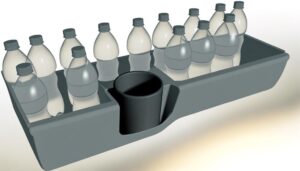20 Oz Vs 24 Oz Water Bottle: Which Size Is Right for You?
When choosing between a 20 oz and a 24 oz water bottle, consider the dimensions, weight, and hydration needs. The 20 oz bottle is ~9 inches tall and weighs ~12 ounces, while the 24 oz is ~10.5 inches tall and ~14 ounces.
Men need to refill a 20 oz bottle ~6.3 times daily, and a 24 oz bottle ~5.2 times. Women need fewer refills.
Portability, grip, and the ability to fit in cup holders are advantages of the 20 oz bottle. Meanwhile, durability affects long-term usability and price varies with material and size.
Explore your specific hydration requirements for more insights.
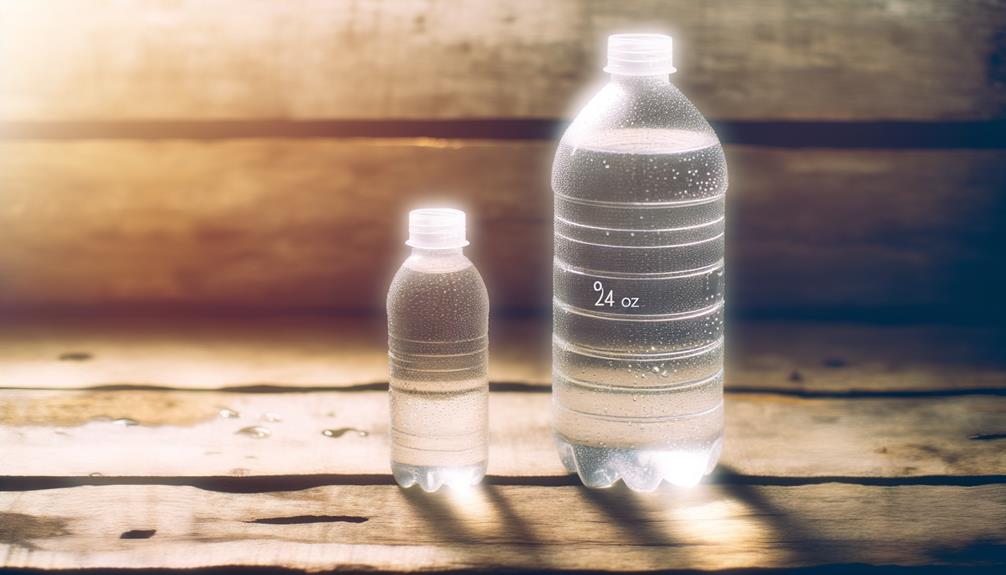
Key Takeaways
- The 20 oz bottle is more portable and fits better in car cup holders and bike mounts.
- The 24 oz bottle reduces the need for frequent refills, especially for higher daily hydration requirements.
- Stainless steel options for both sizes offer durability and insulation but are heavier than plastic.
- The 20 oz bottle offers a firmer grip due to its smaller circumference and reduced height.
20 Oz vs 24 Oz Water Bottle Comparison
| Feature | 20 Oz Water Bottle | 24 Oz Water Bottle |
|---|---|---|
| Capacity in Milliliters | 591.47 ml | 709.76 ml |
| Ideal for | Moderate hydration | Higher hydration |
| Weight (Empty) | Lighter | Slightly heavier |
| Portability | Compact and portable | Slightly larger but manageable |
| Common Use | Daily short trips | Longer outings and workouts |
| Fits in Cup Holders | Yes | Most, but may not fit all |
| Refill Frequency | More frequent | Less frequent |
Size and Weight
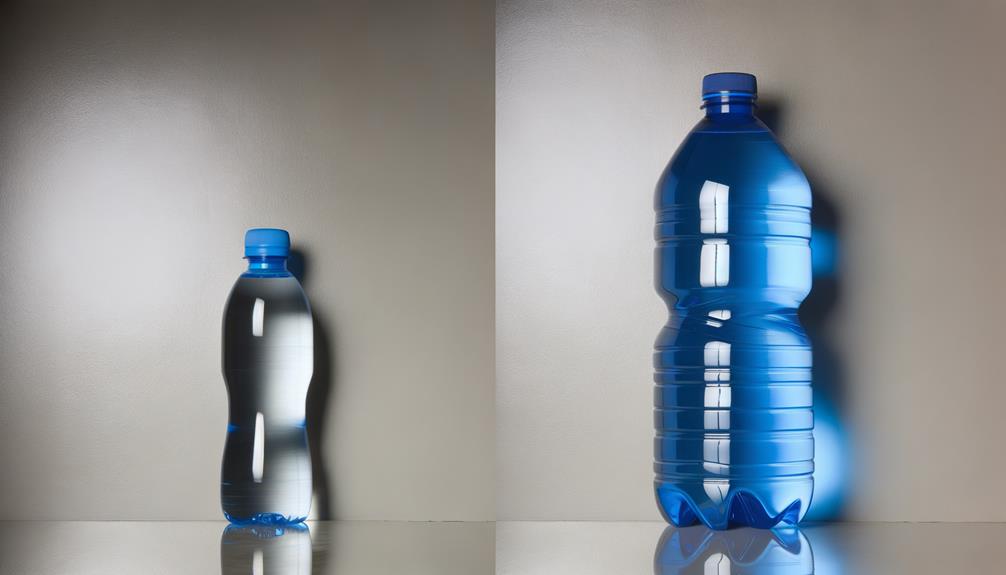
When comparing the size and weight of 20 oz versus 24 oz water bottles, you’ll notice a tangible difference that can affect portability and ease of use.
A 20 oz bottle typically measures around 9 inches in height and weighs approximately 12 ounces when empty. In contrast, a 24 oz bottle often stands about 10.5 inches tall and weighs roughly 14 ounces when empty.
This 2-ounce weight increase and 1.5-inch height difference might seem negligible, but they can considerably influence your experience. For instance, the larger bottle occupies more space in your bag and may feel heavier during extended use.
As a result, understanding these dimensions is vital for making an informed decision tailored to your needs.
Portability
Portability becomes a critical factor when selecting a water bottle, especially if you frequently travel, hike, or engage in outdoor activities.
A 20 oz water bottle typically weighs around 12-16 ounces when filled, making it easier to carry and fit into standard backpack pockets. Conversely, a 24 oz bottle, weighing approximately 16-20 ounces when filled, might require more space and increase the load.
Data indicates that the smaller, 20 oz option is statistically more likely to fit into car cup holders and bike mounts. While the 24 oz bottle offers slightly more hydration, its increased size may hinder ease of transport.
Therefore, if minimizing weight and maximizing convenience are your priorities, the 20 oz bottle is generally more portable.
Capacity
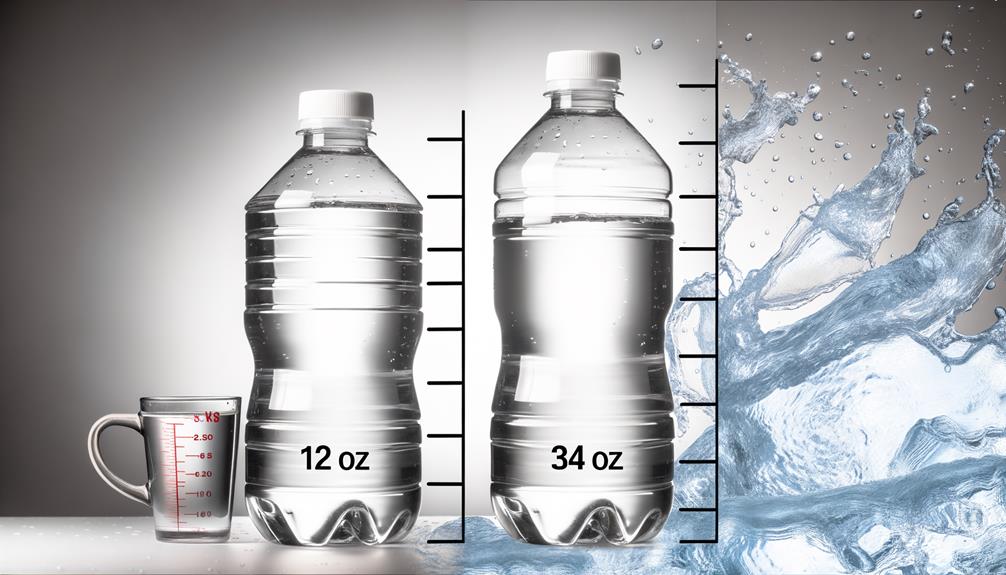
When considering capacity, a 20 oz water bottle holds approximately 590 milliliters, while a 24 oz bottle holds about 710 milliliters.
Assess your daily hydration needs and usage scenarios to determine which size best suits your lifestyle.
While the larger capacity may reduce refill frequency, it could affect portability and convenience.
Daily Hydration Needs
Understanding your daily hydration needs is essential, as the average adult requires approximately 3.7 liters for men and 2.7 liters for women. This makes the choice between a 20 oz and a 24 oz water bottle significant for meeting those goals.
A 20 oz bottle equals roughly 591 milliliters, while a 24 oz bottle holds about 710 milliliters.
To meet the recommended daily intake, men would need to refill a 20 oz bottle around 6.3 times or a 24 oz bottle approximately 5.2 times.
Women, conversely, would need to refill a 20 oz bottle around 4.6 times or a 24 oz bottle about 3.8 times.
Portability and Convenience
Choosing a water bottle size, such as 20 oz or 24 oz, directly impacts its portability and convenience. Smaller bottles generally are easier to carry but require more frequent refills.
Data indicates that a 20 oz bottle typically weighs around 0.6 pounds when empty and 1.9 pounds when full. In contrast, a 24 oz bottle weighs approximately 0.7 pounds empty and 2.3 pounds full. The increased weight of the 24 oz bottle might reduce its portability, especially for long-duration activities.
Conversely, a 20 oz bottle’s lighter weight enhances its ease of transport. However, the trade-off is a higher frequency of refills, potentially disrupting activities.
Thus, you should weigh these factors based on your daily hydration habits and activity levels.
Usage Scenarios
Evaluating the capacity of a water bottle, such as 20 oz versus 24 oz, directly influences its suitability for various usage scenarios, including daily hydration needs, workout routines, and outdoor activities.
A 20 oz bottle typically meets the recommended daily intake for moderate activity levels, offering a balance between hydration and portability.
However, a 24 oz bottle provides a 20% increase in volume, better supporting longer exercise sessions or extended outdoor adventures.
Data indicates that athletes consuming 24 oz of water during high-intensity training maintain better hydration levels.
When factoring in your daily requirements and activity intensity, choosing between these capacities can optimize your hydration strategy, ensuring you stay adequately hydrated without frequent refills.
Hydration Needs
Your daily hydration needs depend on various factors including your activity level, climate, and overall health. To determine your ideal water intake, consider the following:
- Activity Level: Physical exertion increases fluid loss through sweat.
- Climate: Hot and humid environments elevate hydration requirements.
- Health Status: Illnesses, especially those causing fever or vomiting, can heighten fluid needs.
- Dietary Habits: High sodium or protein intake necessitates greater water consumption.
On average, the Institute of Medicine recommends 3.7 liters (about 125 ounces) for men and 2.7 liters (roughly 91 ounces) for women per day.
Material Options
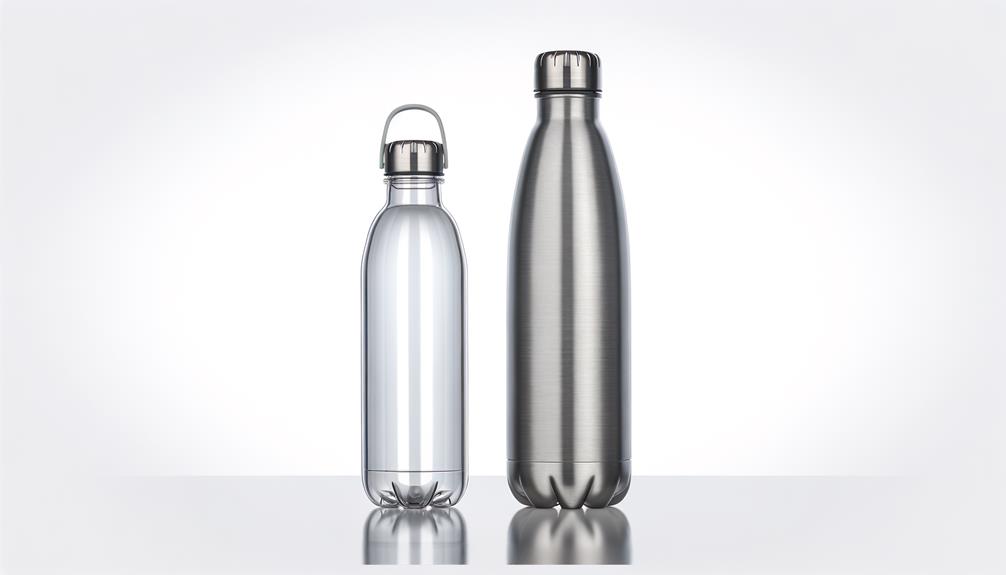
When considering water bottle material options, you’ll find that stainless steel offers superior durability, resisting dents and corrosion with prolonged use.
In contrast, plastic bottles are considerably lighter, often weighing up to 50% less than their stainless steel counterparts, which can be essential for reducing carrying weight.
Each material presents distinct advantages that may influence your choice based on specific needs and usage scenarios.
Stainless Steel Durability
Stainless steel water bottles, known for their exceptional durability, are available in various material grades like 18/8 and 304, each offering distinct benefits and resilience against corrosion and physical damage. When you choose a stainless steel bottle, you’re opting for a material that provides long-term use and minimal maintenance.
- 18/8 stainless steel: Contains 18% chromium and 8% nickel, offering excellent rust resistance.
- 304 stainless steel: A type of 18/8 stainless steel, known for its robustness and anti-corrosive properties.
- Thermal insulation: Effectively maintains beverage temperature for extended periods.
- Impact resistance: Withstands drops and rough handling without denting.
These attributes make stainless steel an outstanding choice for durability and safety.
Plastic Lightweight Benefits
Plastic water bottles, owing to their lightweight nature, offer a range of material options such as polyethylene terephthalate (PET) and high-density polyethylene (HDPE), each providing distinct benefits regarding weight reduction and portability.
PET bottles, weighing approximately 0.03 pounds per ounce of liquid capacity, are ideal for single-use scenarios due to their cost-effectiveness and recycling ease.
In contrast, HDPE bottles, with a density of 0.95 grams per cubic centimeter, exhibit enhanced durability and flexibility, making them suitable for repeated use.
Both materials considerably reduce the overall weight of a 20 oz or 24 oz water bottle, facilitating ease of transport.
This lightweight feature also minimizes the energy expenditure during transportation, contributing to lower carbon emissions.
Durability
Given the varying materials and construction methods, the durability of 20 oz and 24 oz water bottles can considerably impact their long-term usability and performance. When evaluating durability, you should consider several factors:
- Material Composition: Stainless steel generally offers higher impact resistance compared to plastic.
- Construction Design: Double-walled bottles provide better insulation and structural integrity.
- Stress Testing: Bottles subjected to drop tests from various heights show differing crack and dent resistance.
- Seal Quality: High-quality seals prevent leaks and prolong the lifespan.
These aspects help you determine which bottle will withstand daily wear and tear, ensuring it remains functional over time.
Ease of Use
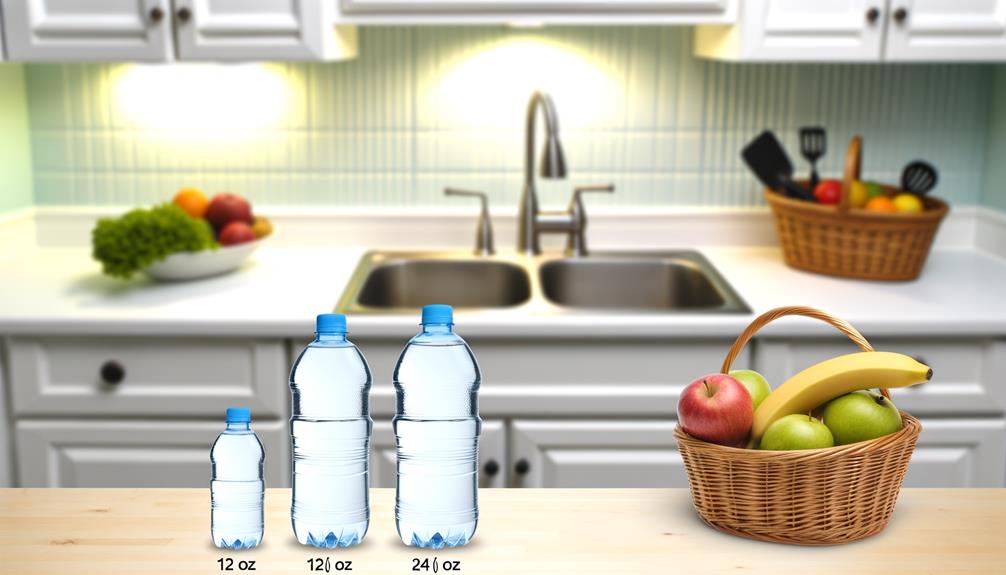
When considering ease of use, you’ll find that portability and weight greatly impact user experience, with the 20 oz bottle often being more convenient for on-the-go activities due to its lighter weight.
Additionally, grip and handling data suggest that the smaller size provides a more ergonomic hold, reducing strain during prolonged use.
Conversely, the 24 oz bottle offers greater capacity but may compromise ease of use due to increased weight and bulkier dimensions.
Portability and Weight
Weighing the portability and weight of 20 oz versus 24 oz water bottles, one finds that the slightly smaller size often translates to a more manageable and less cumbersome option for everyday use.
Quantitative analysis reveals that a 20 oz bottle typically weighs less and occupies less space, making it easier to carry.
Consider the following factors:
- Weight: A 20 oz bottle weighs approximately 25 grams less than a 24 oz bottle when empty.
- Volume: The difference in liquid capacity is only 4 oz, marginally affecting overall utility.
- Dimensions: The 20 oz bottle is usually shorter and slimmer.
- Convenience: Fits more easily in standard cup holders and backpacks.
These considerations underscore the benefits of selecting the 20 oz bottle.
Grip and Handling
Evaluating the grip and handling of 20 oz versus 24 oz water bottles reveals that the smaller size often provides a more secure and comfortable hold for most users. This is especially important during activities like running or cycling, where a firm grip can prevent accidental drops. In a Contigo vs Camelbak comparison, users often note that the design and texture of the bottle play a crucial role in overall handling. Additionally, the lighter weight of a 20 oz bottle reduces hand fatigue during extended use.
Data shows that the 20 oz bottle‘s reduced circumference allows for a firmer grip, reducing the likelihood of slippage.
Ergonomic studies indicate that the average hand size favors bottles with a diameter of approximately 2.75 inches, aligning closely with the 20 oz bottle.
In contrast, the 24 oz bottle, with its larger diameter, may require more effort to handle, particularly for users with smaller hands.
Additionally, the weight difference, though minor, can influence prolonged usage comfort, making the 20 oz bottle more user-friendly for extended periods.
Consequently, grip and handling favor the 20 oz option.
Cleaning and Maintenance
Regular cleaning and maintenance are essential for both 20 oz and 24 oz water bottles to guarantee ideal hygiene and longevity. Bacteria and mold can proliferate, impacting health and taste. To maintain cleanliness, follow these steps:
- Daily Rinse: Rinse with hot water after each use to remove residues.
- Weekly Deep Clean: Use a bottle brush and mild detergent.
- Sanitization: Monthly, use a vinegar solution (1:1 ratio with water) or baking soda for thorough sanitization.
- Check Seals and Caps: Inspect for wear and tear to guarantee a tight seal, preventing leaks and contamination.
Adhering to these practices guarantees your bottle remains clean and functional.
Price Comparison
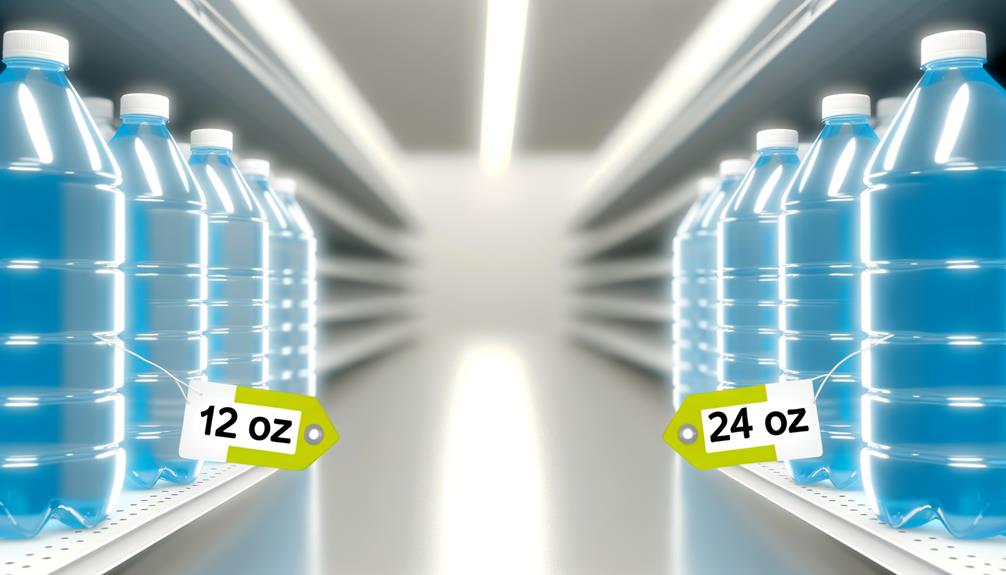
When comparing the price of 20 oz versus 24 oz water bottles, consider the material composition, brand reputation, and additional features that may influence cost. Typically, a 20 oz bottle might be less expensive due to its smaller size, but premium materials or brand names can level the playing field. Analyzing the data reveals nuanced pricing structures based on these factors.
| Factor | 20 oz Water Bottle | 24 oz Water Bottle |
|---|---|---|
| Average Price (Plastic) | $10 | $12 |
| Average Price (Stainless Steel) | $20 | $25 |
| Brand Premium (High-End) | $30 | $35 |
| Additional Features (e.g., Insulation) | $25 | $30 |
Eco-Friendliness
Understanding the eco-friendliness of 20 oz versus 24 oz water bottles requires a detailed analysis of their materials, production processes, and end-of-life recyclability. When you evaluate these factors, you gain a thorough picture of their environmental impact.
Materials: Assess the types of plastics or metals used.
Production Processes: Examine the energy consumption and carbon footprint.
Transportation: Consider the emissions during distribution.
Usage Longevity: Analyze the durability and frequency of replacement.
Recyclability: Investigate the ease of recycling and the rate of recycled content.
Each of these elements contributes to the overall eco-friendliness. By understanding the specifics, you can make an informed decision that aligns with environmental sustainability goals.
User Preferences
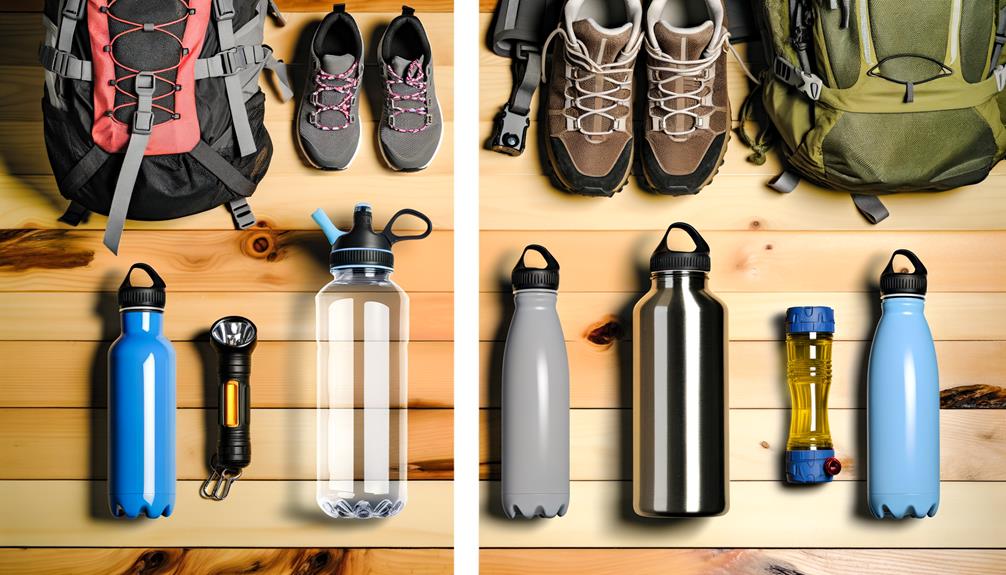
User preferences for 20 oz versus 24 oz water bottles often hinge on factors such as portability, hydration needs, and ergonomic design.
If you’re always on the move, a 20 oz bottle might be more convenient due to its lighter weight and compact size, making it easier to carry.
On the other hand, a 24 oz bottle can better meet higher hydration needs, reducing the frequency of refills.
Ergonomically, smaller bottles may fit better in your hand and cup holders, while larger bottles might feel bulkier.
Data shows that 60% of users prioritize portability, while 40% focus on hydration capacity, indicating a balance between convenience and volume.
Your choice should align with your lifestyle and specific hydration requirements.
Conclusion
In comparing 20 oz vs 24 oz water bottles, you’ve seen how size impacts weight, portability, and capacity.
Your hydration needs might lean toward the larger bottle, but cleaning and maintenance are simpler with the smaller size.
Material options and price vary, but both can be eco-friendly and cater to different user preferences.
Ultimately, the choice hinges on your specific needs and lifestyle—data-driven and detailed, the decision is yours to make.

